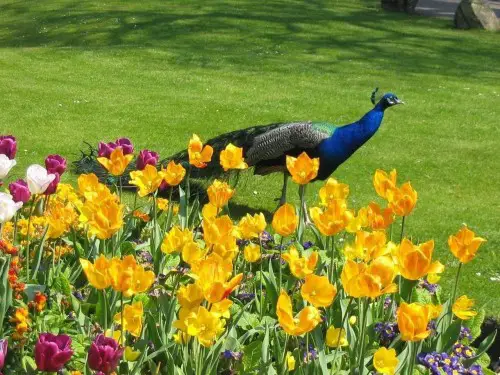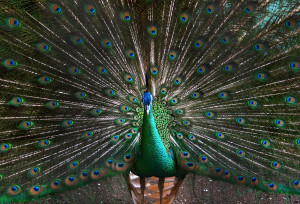This article displays some of the handy Peacock facts for kids that are not presented frequently. Basically there are two species of flying birds that belongs to the pheasant family and is known as peafowl. The male is identified as a peacock whereas females are called peahen; juveniles (chicks) are recognized as peachicks. Peacock is the national bird of India. More than three thousand years ago, Phoenicians brought several species to Egypt and used for several purposes including decorating.
Peacock Facts for Kids
- The color of an adult peafowl (female) is grayish brown.
- Peachicks might exhibit yellowish orange color along with some dark patches.
- The plumage of an Indian peacock has bluish green color.
- Astounding colors exhibit through its feathers whenever the peacock flaps its wings.
- In females, there is a mixture of dull green and brown color in a plumage.
- The plumage color differs as we move around several peacock species.
- The color of the wings is black but it gives blue shine.
- There is a combination of red and blue color in brown feathers.
- More than 60% of the peacock’s body is covered with feathers.
- The males are chosen by females on the basis of their color, size, and length of the feathers.
- Peafowl lays 3 – 5 eggs in one month.
- The average lifespan of peacocks is 20 years.
- The peacocks are 35 – 50 in (90 – 130 cm) long.
- The length of the tail is 1.5 m (5 ft).
- The peacocks weigh around 4 – 6 kg (8.75 – 13 lbs).
- The males are relatively more colorful as compared to females.
- There are more than 200 elongated feathers which the peacocks display.
- The birds have an insensitive sound.
- As compared to the elegant beauty of its feathers, peacocks have ugly legs.
- The females are considerably smaller in size in comparison to the males.
- One of the fascinating sights to watch is when these birds elaborate a courtship dance through fanning out the tail and preening its feathers.
- These birds can’t fly like other birds; however, peacocks can take a short flight of few meters above the ground whenever they sense danger.
- The females are mainly responsible for incubating (keeping warm) eggs and the incubation period lasts for 28 days.
- While the predators arrive, peacocks tend to hide themselves in the trees.
- Harem is the combined name of peahens (females).
- Party is the collective name of a group of peacocks.
- Bevy is the name given to the family of peacocks.
- Peacocks are not endangered species.
- The maximum age of these species under captivity is 40 years.
- These birds turn out to be fully mature after 10 – 12 months.
- The beak is 1 inch long.
- The length of the male peafowls is 2.3 m (7.5 ft).
- These birds like to play under the sunlight.

Peacock Behavioral Facts
These birds present a strange behavior in that they build nests on the ground and perch on the trees.
- These birds are aggressive and do not accept any uninvited creature or even other peafowl in his territory. However, the chicks tend to cross the territorial jurisdiction generally. These crossing juveniles must belong to those parents for which they transverse the territory, otherwise adults would not greet them.
- Peacocks are highly sociable birds and they are very fond of interacting with humans by showing magnanimity toward them.
- These birds travel in colonies of 8 – 10 peacocks.
- While the mating season arrives, the peacocks produce a loud sound.
Facts about the Peacock’s Diet
- These are the omnivorous birds and the prime part of their diet includes plants, seeds, small insects, reptiles, amphibians, and seed heads.
- Peacocks are the best when it comes to the fight against snakes. They don’t allow snakes to approach or even enter into its territory.
- Small mammals and reptiles also form an essential part of their diet.
- Flower petals and anthropods are also vital section of their diet.
Where do Peacocks live?
Peacock facts about its population are as follows:
- Peacocks are symbolized as a primary bird in India and Burma.
- In countries like Japan and England, these birds are kept in captivity in order to extend its population to other parts of the world.
- In South Florida, the law has been enforced to give a sheer protection to peacocks.
- Peacocks are extensively available around different parts of India including Jammu and Kashmir, and river Indus.
Types of Peacocks
There are around three main types of peacocks which are as under:
- African Congo Peacock
- Green Peacock
- Indian Peacock
Peacock’s Predators
Following are the few peacock predators:
- Cats
- Dogs
- Tigers
- Raccoons
- Medium sized Mammals
Cultural Significance of Peacock
- Peacocks stands for wisdom, knowledge, compassion, kindness, and benevolence in Hindusim. In India, the bird is mostly correlated with Saraswati.
- The peacocks are recognized as goddess Hera in the Greek and Roman mythology. The peacock eyes are believed to represent heavens and the stars.
- In the era of Babylonians, the bird acts as a guardian to royalty.
- In Christianity, the peacock symbolizes an everlasting life.
Evolution
- Charles Darwin talks about the evolutionary progress of peacocks in his famous book “On the Origin of Species” in which he argued that the display of peacocks are unique amongst any species.”
- Besides, a research was carried out in Japan which implied that the female demonstrates apathetic behavior toward the male display of plumage.
- Joseph Jordania concluded that the exceptional display of colors from its tail is not actually the gender based selection but the natural selection. The purpose of which is to swerve its predator rather than to attract females.

Subspecies
Peacock facts about its subspecies are listed below:
- Indian or Blue Peafowl
- Green Peafowl
- Congo Peafowl

Leave a Reply